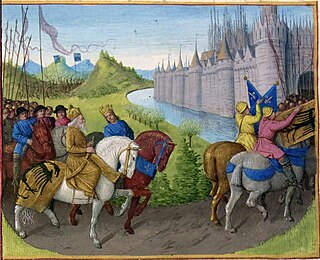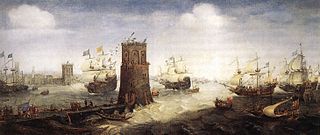
Andrew II, also known as Andrew of Jerusalem, was King of Hungary and Croatia between 1205 and 1235. He ruled the Principality of Halych from 1188 until 1189/1190, and again between 1208/1209 and 1210. He was the younger son of Béla III of Hungary, who entrusted him with the administration of the newly conquered Principality of Halych in 1188. Andrew's rule was unpopular, and the boyars expelled him. Béla III willed property and money to Andrew, obliging him to lead a crusade to the Holy Land. Instead, Andrew forced his elder brother, King Emeric of Hungary, to cede Croatia and Dalmatia as an appanage to him in 1197. The following year, Andrew occupied Hum.

The Kingdom of Jerusalem, also known as the Latin Kingdom, was a Crusader state that was established in the Levant immediately after the First Crusade. It lasted for almost two hundred years, from the accession of Godfrey of Bouillon in 1099 until the fall of Acre in 1291. Its history is divided into two periods with a brief interruption in its existence, beginning with its collapse after the siege of Jerusalem in 1187 and its restoration after the Third Crusade in 1192.

Year 1147 (MCXLVII) was a common year starting on Wednesday of the Julian calendar.

Year 1227 (MCCXXVII) was a common year starting on Friday of the Julian calendar.

The Battle of Varna took place on 10 November 1444 near Varna in eastern Bulgaria. The Ottoman army under Sultan Murad II defeated the Crusaders commanded by King Władysław III of Poland and Hungary, John Hunyadi and Mircea II of Wallachia. It was the final battle of the unsuccessful Crusade of Varna, a last-ditch effort to prevent further Ottoman expansion into the Balkans.

The Fifth Crusade (1217–1221) was a campaign in a series of Crusades by Western Europeans to reacquire Jerusalem and the rest of the Holy Land by first conquering Egypt, ruled by the powerful Ayyubid sultanate, led by al-Adil, brother of Saladin.

Hugh I succeeded to the throne of Cyprus on 1 April 1205 underage upon the death of his elderly father Aimery, King of Cyprus and Jerusalem. His mother was Eschiva of Ibelin, heiress of that branch of Ibelins who had held Bethsan and Ramleh.

The siege of Belgrade, or siege of Nándorfehérvár was a military blockade of Belgrade that occurred 4–22 July 1456 in the aftermath of the fall of Constantinople in 1453 marking the Ottomans' attempts to expand further into Europe. Led by Sultan Mehmed II, the Ottoman forces sought to capture the strategic city of Belgrade, which was then under Hungarian control and was crucial for maintaining control over the Danube River and the Balkans.

The Second Battle of Kosovo was a land battle between a Hungarian-led Crusader army and the Ottoman Empire at Kosovo field that took place from 17–20 October 1448. It was the culmination of a Hungarian offensive to avenge the defeat at Varna four years earlier. In the three-day battle the Ottoman army under the command of Sultan Murad II defeated the Crusader army of regent John Hunyadi.

The Crusades were a series of religious wars initiated, supported, and sometimes directed by the Christian Latin Church in the medieval period. The best known of these military expeditions are those to the Holy Land in the period between 1095 and 1291 that were intended to reconquer Jerusalem and its surrounding area from Muslim rule after it had been taken by force centuries earlier. Beginning with the First Crusade, which resulted in the conquest of Jerusalem in 1099, dozens of military campaigns were organised, providing a focal point of European history for centuries. Crusading declined rapidly after the 15th century.
Balian I Grenier was the Count of Sidon and one of the most important lords of the Kingdom of Jerusalem from 1202 to 1241. He succeeded his father Renaud. His mother was Helvis, a daughter of Balian of Ibelin. He was a powerful and important representative of the native aristocracy during the three Levantine crusades of the first half of the thirteenth century.

Guérin de Montaigu, also known as Garin de Montaigu or Pierre Guérin de Montaigu, was a nobleman from Auvergne, who became the fourteenth Grand Master of the Knights Hospitaller, serving from 1207–1228. He succeeded the Grand Master Geoffroy le Rat after his death in 1206, and was succeeded by Bertrand de Thessy.

The siege of Jajce was a siege of the town of Jajce and its citadel in 1463, in a push by Ottomans to conquer as much of the Bosnian Kingdom, and continuation of the Ottoman–Hungarian Wars. After the fall of Travnik and royal fortress of Bobovac, in the initial days of invasion, Ottomans, led by Sultan captured the town. One of the parties pursued Bosnian King Stjepan Tomašević, and caught up with him at Ključ fortress, after which he was brought to Jajce and executed. Soon the Ottomans forces withdraw, leaving the town under the protection of a small garrison. The Hungarian took the opportunity to capture the citadel, and this meant that Ottoman advancement in Bosnia was halted for the time being. The northern part of Bosnia were brought under Hungarian control, and divided into three administrative regions, Banate of Jajce, Banate of Srebrenik, established around Srebrenik fortress, and a puppet statelet named "Bosnian Kingdom". This situation and Jajce under Hungarian garrison will last until 1527 when the Ottomans finally took the town, and breaking the lines advanced northward to Hungary and westward to Bihać, which was part of the Kingdom of Croatia.
Andrew of Hungary was Prince of Halych–Volhynia between 1227 and 1230, and between 1231 and 1234, and Prince of Zvenyhorod in 1226.

Ladislaus I from the kindred Kán was a powerful Hungarian baron, who held several secular positions during the reign of kings Andrew II and Béla IV.

The Barons' Crusade (1239–1241), also called the Crusade of 1239, was a crusade to the Holy Land that, in territorial terms, was the most successful crusade since the First Crusade. Called by Pope Gregory IX, the Barons' Crusade broadly embodied the highest point of papal endeavor "to make crusading a universal Christian undertaking." Gregory IX called for a crusade in France, England, and Hungary with different degrees of success. Although the crusaders did not achieve any glorious military victories, they used diplomacy to successfully play the two warring factions of the Ayyubid dynasty against one another for even more concessions than Frederick II had gained during the more well-known Sixth Crusade. For a few years, the Barons' Crusade returned the Kingdom of Jerusalem to its largest size since 1187.
De itinere Frisonum is an eyewitness account written in Latin of the Frisian crusaders' journey from Friesland to Acre during the Fifth Crusade (1217–1218). The narrative was composed by an anonymous participant of the venture who most likely was a member of the clergy. Abbot Emo of Friesland of the Premonstratensian monastery of Bloemhof copied it without alterations into his chronicle. Emo's version is the only surviving copy of the lost original and it is kept in the Library of the University of Groningen in the Netherlands. The narrative is noteworthy for its detailed description of the geography of the lands encountered by the Frisian Crusaders on their journey and the author's perspective on the motivations of his compatriots during the venture. The narrative runs parallel up to the Frisian fleet's arrival to Lisbon with the Rhenish text known as Gesta crucigerorum Rhenanorum.
The battle of Mansurah took place from 26–28 August 1221 near the Egyptian city of Mansurah and was the final battle in the Fifth Crusade (1217–1221). It pitted the Crusader forces under papal legate Pelagius Galvani and John of Brienne, king of Jerusalem, against the Ayyubid forces of the sultan al-Kamil. The result was a decisive victory for the Egyptians and forced the surrender of the Crusaders and their departure from Egypt.

The siege of Mount Tabor was a military engagement between the Crusader armies of the Fifth Crusade and the Ayyubids. The combined Crusader armies laid siege to Mount Tabor, which was the objective of the Hungarian Crusade. The crusaders ultimately failed to capture the fort.














